247 Japanese Dog Names Along with Their Meanings
-
Small Dog Place Home
-
Dog Names
-
Japanese Dog Names
›
›
Japanese Dog Names By Janice Jones |Published January 14, 2020
If you adore the culture, travel extensively, or are passionate about Asian food, you may think that Japanese dog names would be perfect for your new pup.
More likely, you’ve fallen in love with a Japanese dog breed such as a Shiba Inu or Japanese Chin, and are aspiring to find just that perfect name that will define your little furball darling. We won’t disappoint, but first, what breeds actually originated in Japan?
Dog Breeds Originating in Japan
Think you’re an expert on Japanese dog breeds?
Let’s find out.
Japan is known for its spitz-type dogs that have ancient origins. “Spitz” type dogs, means they tend to have thick fur, pointed ears, and muzzles. Their tails are heavily plumed, curled, and held over their backs.
Most are larger dogs that won’t be featured on this small breed website, with a couple of exceptions. Many of the native dog breeds in Japan get their names from the region where they originated.
For example, the Hokkaido-Inu is from Hokkaido. The Shikoku-Inu is from Shikoku. You’ll find that some Japanese dog breeds end with Inu and others, ken. Both mean dogs.
Many of the native Japanese dog breeds are extremely rare, even in Japan. Others, such as the Shiba Inu, are viral, thanks to Kabosu, a top-rated and famous Internet dog. Other breeds may not have originated in Japan but were introduced and later developed there, such as the Japanese Chin.
The original Japanese dog breeds share many of the same temperament traits, including loyalty, bravery, and cautiousness. Most are affectionate, intelligent, and relatively easy to train. If you have a Japanese breed puppy, consider our suggestions for Japanese dog names.
Akita Inu
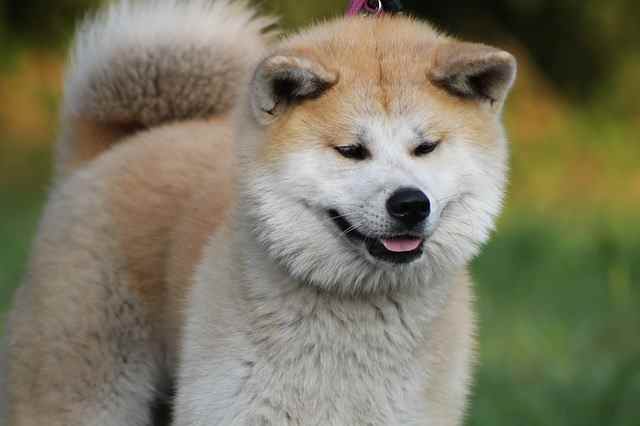 Akita Inu
Akita InuThe Akita is a highly regarded dog breed originating from the northern region of Japan. Specifically, from Akita. Some people think they are just a larger version of the Shiba Inu, but there are more differences than simple appearance.
There are two varieties of the Akita, the Japanese Akita Inu, and the American Akita. Both are considered two separate breeds except in Canada and the U.S.
Probably the most famous Akita Inu was Hachikō, a Japanese Akita owned by a professor at the Tokyo Imperial University. Every day, Hachikō would meet his owner at the Shibuya Station after work. He continued to do this faithfully even after his owner had died of a cerebral hemorrhage at work one day.
As the story goes, each day, for the next nine years, this dog, Hachikō, awaited Ueno’s return, appearing precisely when the train was due at the station.
These dogs can be independent and wary of strangers. They may not do well with other dogs, especially those of the same gender. If you are considering one of these dogs, expect to pay top dollars and spend a considerable amount of time training and socializing. This would not be a good choice for first-time dog owners.
Shiba Inu
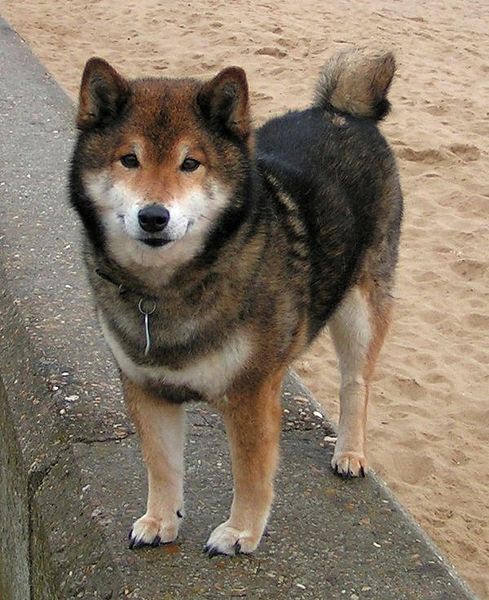
Of all the Japanese dog breeds, the Shiba Inu is the most popular worldwide. They may look like the Akita or Hokkaido in photographs, but they are actually much smaller. Still, they were bred and developed to hunt like other Japanese Breeds, but their prey was smaller.
In Japanese, “Shiba” means “brushwood,” which is a shrub that turns red/brown during Autumn – a color similar to their coat color. They seem to get along better with cats than other dogs and may not be the right choice for families with young children. They, too, will need early socialization and training but have agreeable personalities. They are considered average in intelligence, but because they are also stubborn, training may not always go smoothly.
One remarkable trait that these dogs share is what you might hear as the Shiba Scream. You’ll be likely to listen to this unusual vocalization, whether they are stressed or delighted.
Read more about the Shiba Inu Dog Breed Profile.
Hokkaido Ken
The Hokkaido Inu, also called the Dō-ken, Ainu-ken, Seta, Ainu dog, Hokkaido-Ken, is native to the most northern island, also called Hokkaido and may go by the names Ainu Ken, Seta, and Ainu dog.
Their coats are longer and thicker than other Japanese breeds to help protect them from the cold, harsh winters of the Hokkaido region.
Although larger than the Shiba Inu and smaller than the Akita Inu, these dogs were also used for hunting in the cold, snowy terrains of Northeast Japan.
Kai Ken
The Kai Ken is another rare breed even in Japan but considered to be a national treasure to its home and protected by the Nihon Ken Hozonkai (Nippo).
They were bred to hunt deer, boar, and even bears in the mountainous region of Yamanashi. They are a versatile breed with athletic abilities that include swimming, climbing trees, and of course, hunting. You might find this breed represented in the Japanese anime and manga.
Shikoku Inu
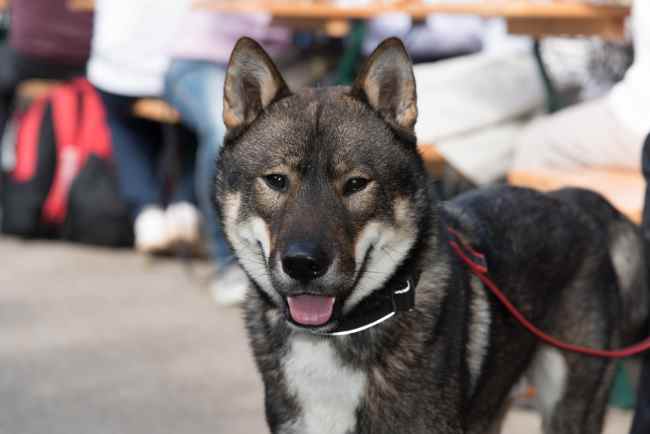 Shikoku Inu
Shikoku InuAnother Spitz-type dog that was initially developed in the Shikoku region of southern Japan for hunting. This is a mountainous region, so successful hunting dogs here needed to be fast, agile and able to endure long hunting treks.
Though they resemble the Shiba Inu, they are still officially a separate breed that has been recognized with the AKC in its Foundation Stock Services. It is also recognized with the Japanese Kennel Club and the Canadian Kennel Club.
Kishu Inu or Kisha Ken
The Kishu Ken or Inu is a very ancient breed and may have been bred in Japan for several thousands of years. Wag Walking,
True to form, this breed gets its name because it originated in the Kishu region (Wakayama today), and like most of the other original Japanese breeds, the Kishu was used for hunting deer and boar. They are called the “silent hunter” of Japan because of their stealthy methods of hunting—always alert and light on their feet, they can sneak up on their prey before the prey is even aware of their presence.
Japanese Chin
No one knows for sure where these dogs originated. Some say China and others, Korea. As with other Asian breeds, these dogs could have been the product of Buddhist monks, Chinese emperors, or ancient merchants, but what is known is that the Japanese had a roll in perfecting the breed we recognize today.
They were likely crossed with other small spaniel type dogs until they reached the look of today. It wasn’t until around 1854 that Japan first reopened trade after 200 years of isolation, thanks to Commodore Matthew Perry, who sailed into Uraga Harbor near Edo — now modern-day Tokyo.
After that, the Japanese Chin became a popular product and were imported into Britain and the United States.
Today, the Chin is likely the smallest of all the Japanese breeds weighing in between 7 and 10 pounds. It is also the most cat-like. The Japanese Chin is catlike in many ways.
Just like cats, the Japanese Chin likes to groom himself by licking his paws and wiping them on his face and head. They also love to be perched high up, so expect to see one sitting on the back of a sofa or on a table.
People who have owned Chin say that they are so sensitive that their humans’ emotions tend to shape their own personalities. This may be true of other small breeds as well.
For example, Chins in quiet homes tend to be quiet and reserved, whereas those raised in noisy, active homes won’t stay quiet or lazy for long.
Read more about the Japanese Chin Dog Breed Profile
Japanese Spitz
The Japanese Spitz looks very similar to the German Spitz and American Eskimo dog. As a distinctively Spitz-type dog, they are eager to please, keen to entertain you, and ready to learn.
It is believed that these dogs were developed from white German Spitz dogs that were introduced into Japan around 1920 through Siberia and China. As with most dog breeds, history is unknown because most breeding records were destroyed during WWII.
Unlike many of the traditional Japanese breeds, this dog is entirely a companion breed, preferring to be inside, warm, and near your side. Still, they are playful, energetic, and affectionate. In April 2019, this breed was introduced into the American Kennel Club Foundation Stock Services.
Read more about the Japanese Spitz Dog Breed Profile
Japanese Terrier
The Japanese Terrier is often referred to as the Nippon Terrier and is extremely rare even in Japan. The theory goes that the ancestors of this breed were brought to Japan by Dutch merchant ships and then crossed with fox terriers, pointers, and other indigenous Japanese dogs.
Much of their history is shrouded in mystery, so we may never know exactly how they came to be one of Japan’s smallest rare breeds.
Read more about the Japanese Terrier Dog Breed Profile
Tosa Inu
The Tosa Inu is another rare dog breed from the region of Tosa, Japan and is often referred to as the Japanese mastiff because of its colossal size. They were initially bred to be fighting dogs but used today mainly as guard dogs. The Tosa Inu was developed in the 19th century using the Shikoku Inu, English mastiff, Saint Bernard, English Bulldog, Great Dane, German Pointer, and Bull Terrier.
They can be found all over the world today, but those bred in Japan are much smaller than their cousins bred abroad.
Any of these native Japanese breeds would love love to have a Japanese Dog Name.
Japanese Dog Names
You can find the perfect Japanese Dog Names by look at the culture of Japan. Visit place names, food and common words that most western English speaking people will recognize. Or, find traditional boy and girl Japanese names along with their meanings from the lists below.
Japanese Dog Names Based on Places in Japan
 Japanese Dog Names Based on Place Names
Japanese Dog Names Based on Place NamesAshi – a lake
Fuji – another city in central Japan
Fushimi – a shrine in Kyoto.
Kawasaki – the city, located between Tokyo and Yokohama.
Kobe – the sixth-largest city in Japan
Kochi – the capital city of Kochi Prefecture, situated on the Kagami River
Kyoto – a city located in central Japan.
Oki –a chain of more than a hundred small islands southwest of mainland Japan
Osaka – one of Japan’s largest cities
Sapporo – Japan’s fifth-largest city
Tokyo – the capital of Japan
Yoko – Yokohama located south of Tokyo
Japanese Dog Names Based on Japanese Food Everyone Can Relate To
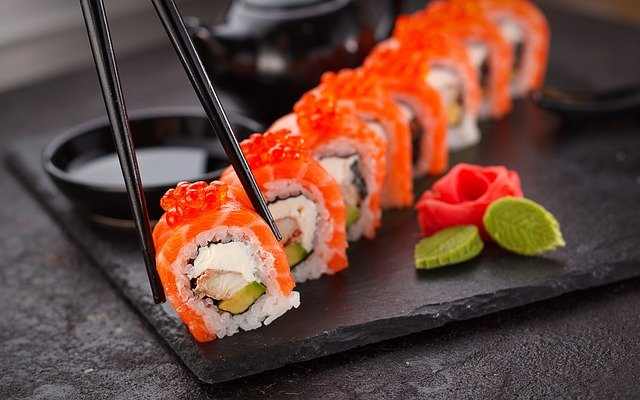 Japanese Dog Names Based on Food
Japanese Dog Names Based on FoodEdamame – young soybeans served in the pod after blanching and salting
Hibachi – Grill used to cook traditional Japanese dishes
Manjū – confection made from flour or rice powder and filled with red bean paste
Miso – soup made with a stock called dashi and other ingredients such as fish and kelp
Natto – made by fermenting soybeans and smells similar to moldy cheese
Pocky – a type of biscuit snack popular with children.
Ramen – a Japanese soup dish.
Rice Cake – Not the best example, but a great name for a white dog.
Ryokucha – a Japanese green tea.
Sake – a Japanese rice wine.
Sashimi – fresh raw meat or fish sliced into thin pieces. Often confused with sushi
Sesame – a common ingredient found in many Japanese dishes
Soba – the Japanese name for buckwheat. It’s commonly used for noodles.
Sushi – A favorite world-wid; sushi rice, vegetables, raw fish or seafood is combined,
Tempura – a Japanese meal consisting of thickly battered and fried seafood or vegetables
Tofu – food made from soy milk that is thickened and pressed into white blocks, sometimes soft, and other times firm.
Udon –wheat flour noodles in Japanese cuisine.
Wasabi – spicy horseradish
Japanese Dog Names for Girls
Ai – pronounced eye meaning love
Aiko – child of love
Airi – love jasmine
Akemi – bright beautiful
Akiko – bright child
Akira – bright/clear
Asami – morning beauty
Asuka – tomorrow perfume, fragrance
Ayame – iris
Ayano – my color
Ceiko – child of splendor
Chieko – child of intelligence, wisdom
Chika – scatter flowers
More Japanese Dog Names for Girls
Chiyo – one thousand generations
Chiyoko – child of a thousand generations
Emi – beautiful blessing
Emiko – beautiful blessing child
Eri – blessed prize
Etsuko – child of joy
Fumiko – child of abundant beauty
Hana – flower
Hanako – flower child
Haru – spring
Haruko – spring child
Haruna – spring vegetables
Hideko – child of excellence
Hikari – light, radiance
Hina – sun vegetables
Hiro – generous
Hiroko – generous child
Hiromi – generous beauty
Hisako – child of long life
Hitomi – the pupil of the eye
Honoka – harmony flower
Hoshi – star
Hoshiko – star child
Hotaru – firefly
Izumi – spring, fountain
Kamiko – superior child
Katsumi – victorious beauty
Kazuko – child of harmony
Kazumi – harmonious beauty
Kei – (Pronounced Kaye) happiness
Keiko – blessed child / respectful child
Kiko – chronical child
Kimi – noble
Kimiko – empress child
Kiyomi – pure beauty
Kumiko – a long-time beautiful child
Kyo – cooperation
Kyoko – respectful child
Madoka – circle, round
Mai – dance
Maiko – child of dance
Maki – true hope
Makoto – sincere
Mami – true beauty
Female Puppy Japanese Dog Names for Girls
Mana – love
Manami – loving beautiful
Mao – dance cherry blossom
Mariko – village child
Masa – just / true
Masumi – true clarity
Mayumi – true gentle beauty
Mi – beautiful
Michi – pathway
Michiko – beautiful, wise child
Mieko – beautiful blessing child
Miho – protected, guaranteed beauty
Mika – beautiful fragrance
Miki – beautiful princess
Miku – beautiful sky
Minako – beautiful child
Minori – truth
Mio – beautiful cherry blossom
Misaki – beautiful blossom
Mitsuko – child of light
Mitsuru – satisfy, full
Miwa – beautiful harmony, peace
Miyako – beautiful night child
Miyu – beautiful gentle
Miyuki – blessing
Japanese Dog Names for Girls: More Ideas
Momoka – peach tree flower
Moriko – child of the forest
Nana – seven
Nanami – seven seas
Nao – honest
Naoko – honest child
Naomi – honest beautiful
Natsuki – summer hope
Natsumi – beautiful summer
Nobuko – faithful, trustworthy child
Noriko – lawful child
Ren – lotus/love
Rika – true fragrance
Riko – child of truth
Rin – dignified
Rina – jasmine
Still More Suggestions for Japanese Dog Names for Girls
Rio – village cherry blossom
Ryoko – refreshing child
Sachiko – joyful, happy child
Saki – bloom of hope
Sakura – cherry blossom
Satoko – wise child
Satomi – beautiful and wise
Shigeko – growing child
Shika – deer
Shinju – pearl
Shiori – poem
Shizuka – quiet summer
Shizuko – quiet child
Sora – sky
Sumiko – child of clarity
Suzu – bell
Suzume – sparrow
Takako – noble child
Takara – treasure
Tamiko – child of many beauties
Teruko – shining child
More Ideas for Japanese Dog Names for Female Dogs
Tomiko – child of wealth, fortune
Tomomi – beautiful friend
Toshiko – clever child
Umeko – plum child
Wakana – harmonious music
Yasu – peace
Yasuko – child of peace
Yoko – child of sunlight
Yoshi – lucky/righteous
Yoshie – beautiful stream
Yoshiko – child of goodness
Yua – binding love
Yui – bind clothing
Yuina – bind together
Yuka – gentle flower
Yukari – beautiful pear tree
Yuki – happiness/snow
Yukiko – child of happiness
Yuko – a gentle child
Yumi – reason beautiful
Yumiko – reason beautiful child
Yuri – lily
Yuriko – lily child
Yuuna – gentle
Japanese Dog Names for Boys
Akemi – the beauty of dawn
Aki – bright / autumn
Akihiro – Shining Abroad
Arata – Fresh
Botan – Flower for June
Dai – Beloved and adored one
Eiji – Splendid Ruler
Haru – Born in the spring
Haruki – shining sun
Haruto – sun flying
Hideki – excellent timber trees
Hiroaki – spacious light
Hiroki – vast timber trees
Jiro – Second born son
Joji – Farmer
Jun – Obedient
Juro – Tenth son
Kaoru – fragrance
Katashi – firm
More Japanese Dog Names for Boys
Katsu – Victory
Kenta – Healthy, stout
Kisho – One who knows his own mind
Koji – Happy second-born son
Masa – Good Son
Michi – Pathway
Nao – Honest
Nobu – Faith
Norio – Man of principles
Renjiro – an honest and upright man
Ringo – Apple; Peace be with you
Ryo – Excellent
Seiko – The force of truth
Shima – an Island Dweller
Shiro – fourth-born son
Shun – Quick or smart
Shuu – Responsible man
Still More Japanese Dog Names for Boys
Taiki – great radiance, shine
Takahiro – of great value, nobility
Taashi – prosperous, noble
Tama – a Jewel
Taro – Strong A great son
Tomi – Rich, wealthy, red
Toru Wayfarer
Toyo – Plentiful
Yogi – one that practices Yoga
Yori – Dependence
Yu – Resembling Jade
Yuji – Courageous second son
Yuki – brave spirit
Yuri – To hear
Yuta – strong and masculine
More Familiar Japanese Words That Make Great Japanese Dog Names
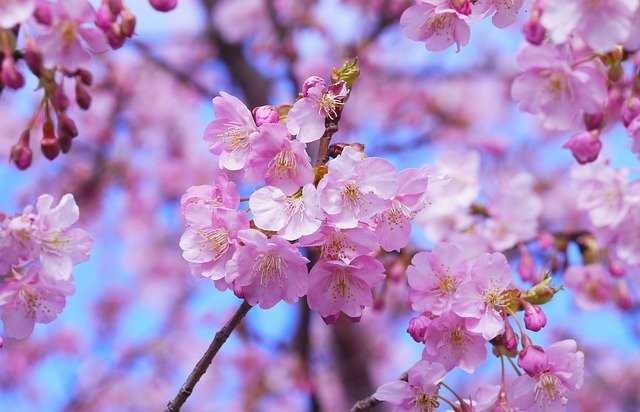 Cherry Blossoms
Cherry BlossomsBlossom – Iconic Japanese Image
Cherry – as in the iconic Japanese cherry blossoms
Emoji popular symbols used in electronic communications
Haiku – Japanese or Chinese poem
Kimono – traditional dress
Bamboo – Common plant grown in Japan
Bento – take out box lunch
Bonsai – tiny trees
Chopstick – eating utensil
Dojo – classroom or hall for learning martial arts
Futon – mat
Geisha – Female entertainer
Ginkgo – grown in Japan and Chinna that has fan-shaped leaves and yellow fruit
Ichi – means one
Karaoke – where amateur singers sing to recorded music
Karate -a type of martial art
Kimono – a traditional full-length robe worn by women, men, children
Koi – type or ornamental fish; great for an orange and white dog
Ninja – Japanese assassins,
Obi – wide belt tied in the back to secure a kimono
Origami – the art of folding paper into paper sculptures
Rickshaw – human pulled wagon
Samurai – ancient warriors
Sensei – teacher
Sudoku – popular number puzzle
Tsunami – colossal wave caused by earthquakes
Typhoon nasty storm
Zen – quiet meditation
Pin for Future Reference
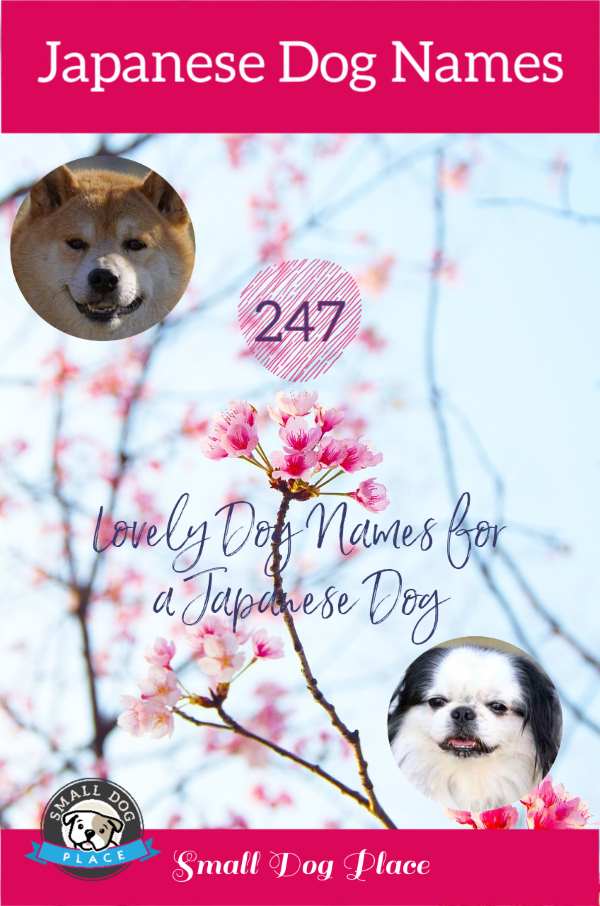 Japanese Dog Names Pin
Japanese Dog Names Pin
Does This Article Deserve Your Thumbs Up?
We always appreciate your support and encouragement. Your thumbs up means so much to us.

Free Monthly Newsletter
Sign Up for Our Free Newsletter and get our Free Gift to You.
my E-book, The Top 10 Mistakes People Make When Choosing a Dog (and how to avoid them)
If you enjoyed this page, I’d love it if you’d let me know. Just click the button below. Thank you.
Sharing is Caring





purple pharmacy mexico price list reputable mexican pharmacies online purple pharmacy mexico price list mexicanpharmonline.com
buying prescription drugs in mexico reputable mexican pharmacies online purple pharmacy mexico price list mexicanpharmonline.shop
bitcoin dark web darknet market list blackweb